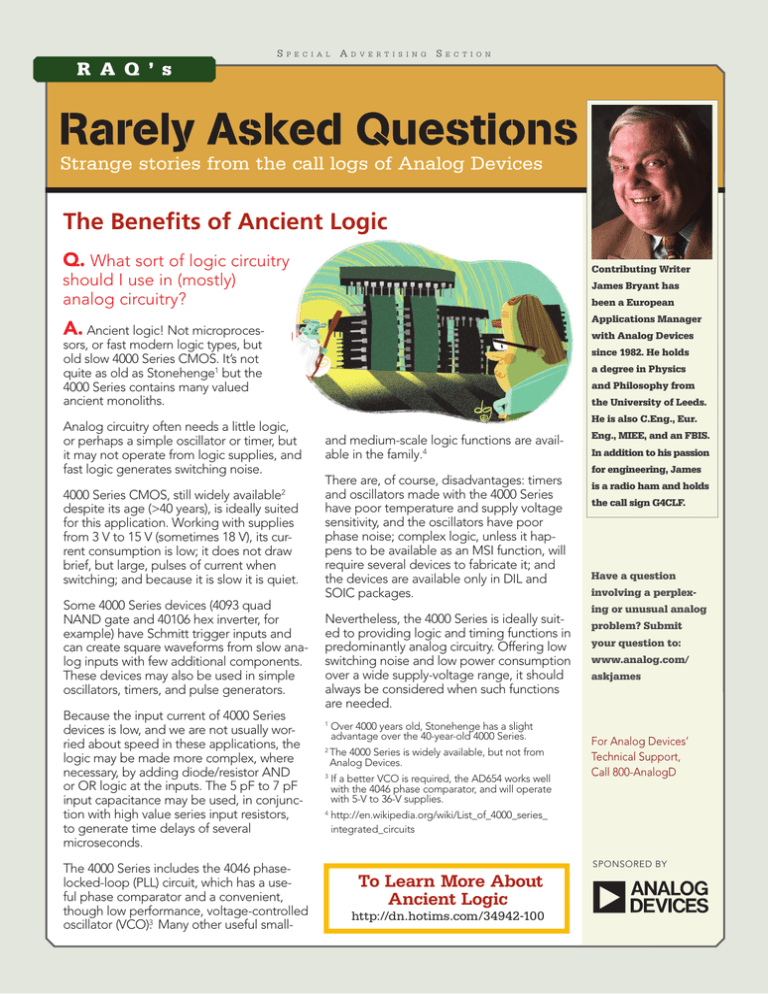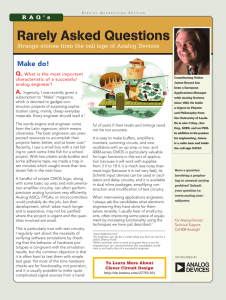R A Q ’ s A.
advertisement

R A Q ’ s S A p e c i a l d v e r t i s i n g S e c t i o n Strange stories from the call logs of Analog Devices The Benefits of Ancient Logic Q. What sort of logic circuitry Contributing Writer should I use in (mostly) analog circuitry? James Bryant has been a European Applications Manager A. Ancient logic! Not microproces- with Analog Devices sors, or fast modern logic types, but old slow 4000 Series CMOS. It’s not quite as old as Stonehenge1 but the 4000 Series contains many valued ancient monoliths. Analog circuitry often needs a little logic, or perhaps a simple oscillator or timer, but it may not operate from logic supplies, and fast logic generates switching noise. 4000 Series CMOS, still widely available2 despite its age (>40 years), is ideally suited for this application. Working with supplies from 3 V to 15 V (sometimes 18 V), its current consumption is low; it does not draw brief, but large, pulses of current when switching; and because it is slow it is quiet. Some 4000 Series devices (4093 quad NAND gate and 40106 hex inverter, for example) have Schmitt trigger inputs and can create square waveforms from slow analog inputs with few additional components. These devices may also be used in simple oscillators, timers, and pulse generators. Because the input current of 4000 Series devices is low, and we are not usually worried about speed in these applications, the logic may be made more complex, where necessary, by adding diode/resistor AND or OR logic at the inputs. The 5 pF to 7 pF input capacitance may be used, in conjunction with high value series input resistors, to generate time delays of several microseconds. The 4000 Series includes the 4046 phaselocked-loop (PLL) circuit, which has a useful phase comparator and a convenient, though low performance, voltage-controlled oscillator (VCO)3. Many other useful small- since 1982. He holds a degree in Physics and Philosophy from the University of Leeds. He is also C.Eng., Eur. and medium-scale logic functions are available in the family.4 There are, of course, disadvantages: timers and oscillators made with the 4000 Series have poor temperature and supply voltage sensitivity, and the oscillators have poor phase noise; complex logic, unless it happens to be available as an MSI function, will require several devices to fabricate it; and the devices are available only in DIL and SOIC packages. Nevertheless, the 4000 Series is ideally suited to providing logic and timing functions in predominantly analog circuitry. Offering low switching noise and low power consumption over a wide supply-voltage range, it should always be considered when such functions are needed. 1 ver 4000 years old, Stonehenge has a slight O advantage over the 40-year-old 4000 Series. The 4000 Series is widely available, but not from Analog Devices. 2 3 If a better VCO is required, the AD654 works well with the 4046 phase comparator, and will operate with 5-V to 36-V supplies. 4 ttp://en.wikipedia.org/wiki/List_of_4000_series_ h integrated_circuits Eng., MIEE, and an FBIS. In addition to his passion for engineering, James is a radio ham and holds the call sign G4CLF. Have a question involving a perplexing or unusual analog problem? Submit your question to: www.analog.com/ askjames For Analog Devices’ Technical Support, Call 800-AnalogD SPONSORED BY To Learn More About Ancient Logic http://dn.hotims.com/34942-100

